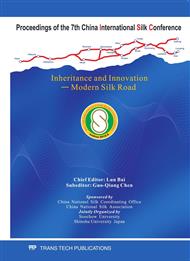p.153
p.158
p.164
p.170
p.176
p.181
p.186
p.192
p.197
Research on Structure and Property of Silk Fibroin Modified Viscose Fiber
Abstract:
Silk fibroin modified viscose fiber (SFVF) was a new fiber with silken handling and luster, which was produced via adding silk fibroin (SF) during the viscose process. In this paper, a series of testing had been done to study the structure and properties of SFVF. The amino acid content of SFVF was measured by HITACHI-835-50 amino acid tester. The morphology, structure, thermal and mechanical property of SFVF were characterized by SEM, FTIR, DSC and electronic strength tester. The results indicated that SFVF consisted of many kinds of amino acids compared with pure viscose fiber (VF) yarn. The results of SEM showed more continuous multi fine slots existed in the longitudinal section of SFVF than in that of VF, demonstrating that wet permeability and vapor transmission could be enhanced for the SFVF to certain extent. Results from FTIR indicated that the secondary structure of SFVF was mainly β-sheet and random coil, and its absorption peaks were 1616cm-1 and 1644 cm-1 respectively. The DSC curve shown the thermal decomposition temperature of SFVF was about 328.39°C, which was close to that of VF. It suggested that the SF modification had no obvious influence on thermal stability of VF. At last, the dry-strength and wet-strength of SFVF was close to that of VF. Therefore, the application of VF would be expanded with the SF modification.
Info:
Periodical:
Pages:
176-180
Citation:
Online since:
January 2011
Authors:
Keywords:
Price:
Сopyright:
© 2011 Trans Tech Publications Ltd. All Rights Reserved
Share:
Citation:


